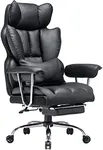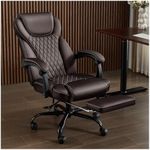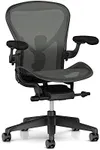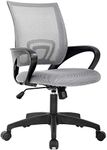Buying Guide for the Best Office Chairs
Choosing the right office chair is important because it directly affects your comfort, posture, and productivity during long hours of work. A good office chair should support your body, help you maintain a healthy sitting position, and be adjustable to fit your unique needs. When shopping for an office chair, focus on features that promote ergonomic support and adjustability, as these will help you stay comfortable and avoid strain or injury over time.Ergonomic DesignErgonomic design refers to how well the chair supports your body’s natural posture and movements. This is important because a chair that fits your body can help prevent back pain and fatigue. Ergonomic chairs often have features like lumbar support, adjustable armrests, and seat depth adjustments. Some chairs offer basic ergonomic features, while others provide more advanced adjustments. If you spend many hours at your desk, look for a chair with multiple ergonomic adjustments to tailor the fit to your body. If you use the chair only occasionally, a simpler ergonomic design may be sufficient.
AdjustabilityAdjustability means how many parts of the chair you can change to suit your body and preferences. This includes seat height, armrest height and width, backrest tilt, and sometimes even the seat depth. The more adjustable a chair is, the easier it is to make it comfortable for your specific body shape and work style. For people who share a chair or want a perfect fit, high adjustability is key. If you are the only user and your needs are simple, basic adjustments like seat height and backrest tilt may be enough.
Lumbar SupportLumbar support is the part of the chair that supports the lower back. This is crucial because sitting for long periods without proper lower back support can lead to pain and poor posture. Some chairs have fixed lumbar support, while others allow you to adjust the height or firmness. If you have a history of back pain or want to prevent it, look for a chair with adjustable lumbar support. If you don’t have specific back issues, a chair with built-in, non-adjustable lumbar support may still provide enough comfort.
Seat Material and PaddingThe seat material and padding affect how comfortable the chair feels and how well it breathes. Common materials include mesh, fabric, and leather or faux leather. Mesh is breathable and good for warmer environments, while fabric and leather can feel softer or more luxurious. Padding can range from thin to thick; thicker padding is usually more comfortable for long sitting sessions, but too much can lose support over time. Choose a material and padding level that matches your comfort preferences and the climate of your workspace.
Seat Height and DepthSeat height and depth determine how well the chair fits your legs and overall body size. The right seat height allows your feet to rest flat on the floor, while the right depth means you can sit back comfortably without the edge of the seat pressing into your knees. Most chairs offer adjustable seat height, but not all allow you to change the seat depth. If you are taller or shorter than average, or if you want a custom fit, look for a chair with both adjustable height and depth. For average-sized users, standard adjustments may be sufficient.
ArmrestsArmrests support your arms and help reduce strain on your shoulders and neck. They can be fixed or adjustable in height, width, and sometimes angle. Adjustable armrests are helpful if you type a lot or need to move your chair close to your desk. If you don’t use armrests much, fixed ones may be fine, but if you want to avoid shoulder tension, look for adjustable options that let you find the most comfortable position.
Mobility and SwivelMobility refers to how easily the chair moves, usually thanks to wheels (casters), and swivel means the chair can rotate. These features are important if you need to move around your workspace or reach different areas of your desk without getting up. Some chairs have smooth-rolling wheels for hard floors or carpets, while others are more basic. If you work at a large desk or need to move frequently, prioritize good mobility and a smooth swivel. For smaller spaces or stationary work, these features may be less critical.
Weight CapacityWeight capacity is the maximum weight the chair is designed to support safely. This is important for safety and durability. Chairs are usually rated for a standard range, but some are built for higher capacities. If you are heavier or want extra durability, check the weight capacity to ensure the chair will be comfortable and long-lasting for you. For most users, standard weight limits are sufficient.














